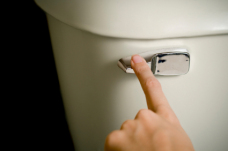Toilet technology at VU in celebration of World Toilet Day
[Originally published in MyVU]
 Vanderbilt is on the cutting edge in medical technology and academic research, but did you know the university is also on the cutting edge of toilet technology?
Vanderbilt is on the cutting edge in medical technology and academic research, but did you know the university is also on the cutting edge of toilet technology?
In celebration of World Toilet Day on Thursday, Nov. 19, here’s some information to think about the next time you have to take a “bio break” on campus:
In 2008, Vanderbilt committed to water conservation and a retrofit of restroom facilities across the campus. An investment was made in low flow, no touch faucets; low flow toilets; and waterfree urinals.
During the retrofit, 492 of these water-conserving fixtures were installed throughout VU’s main campus, exclusive of The Commons. Each year, these fixture retrofits will result in water savings of approximately 9 million gallons – enough water to cover a football field 30 ft. deep in water (30 acre-feet) or fill 304,000 bathtubs.
Low flow, no touch faucets
Using sensor-operated faucets that turn on when hands are present and turn off when hands move away helps limit water flow and prohibits the spread of germs from touching the faucet handle. Low flow faucets use an aerator to mix air in the water reducing the flow necessary to achieve the same wetness by about two-thirds.
Low flow toilets
Toilets are often the single largest users of water in many facilities. One flush of each standard toilet uses 3.5-5.5 gallons of water. Today’s low-flow units require only 1.2- 1.6 gallons per flush. And unlike their predecessors, today’s low-flow toilets are designed to operate very well under low-flow conditions, eliminating the need to flush twice.
Waterfree urinals
Waterfree urinals do not flush, so they use no water. None. Instead, an internal trap is filled with a liquid lighter than urine. The urine sinks below it and is directed down the drain by gravity, eliminating odor from entering the restroom. Each waterfree urinal can save up to 40,000 gallons of water each year over a traditional urinal in a commercial or academic setting.
Dual-flush toilets
One of the newest toilet technologies, dual-flush toilets use less water to flush liquid waste (0.8 gal per flush) and more for solid waste (1.3-1.6 gal per flush). They are designed with a larger trap (the opening in the bottom) and don’t keep much water in the bowl like traditional toilets. Dual-flush toilets are available throughout The Commons and a few other locations on campus.
So, think before you flush and Happy World Toilet Day.
For more information about water conservation at Vanderbilt, visit SustainVU or e-mail sustainvu@vanderbilt.edu.

Leave a Response